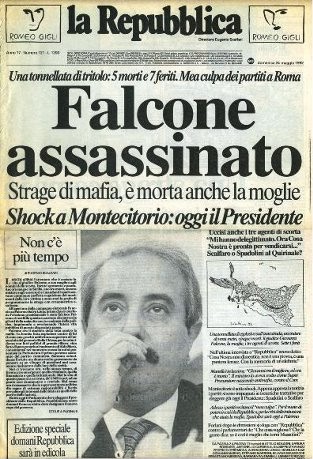So who are these people? Well, there's Charles Manson, of course, who, on Friday, Renee Pickup on this site prematurely announced as dead. I can't blame her for the mistake; the guy apparently took his time dying, though he didn't linger as long as Francisco Franco. Now we know he definitely is dead, and the papers and Internet have been filled with stories about him. For my money, the most complete and well-rounded take on the entire Manson family story is the one that Karina Longworth did on her podcast You Must Remember This. It's a 12 part masterpiece that puts Manson, the family, and the murders in a specific historic and cultural context with a detail and insight I haven't encountered anywhere else. I've mentioned this series here before, and again, if you haven't listened to it yet, now is the perfect time to do so.
But with all the attention on the Manson story, which never ceases to fascinate Americans, the death of another criminal seemed to get short shrift here. At least, I didn't see that much about it, and maybe that's not surprising because the man's actions impacted another country more than it affected the US. I'm talking about "The Beast", "the Boss of Bosses", Salvatore Riina. A Sicilian Mafia chief from the 1970s on, Riina died Friday at the age of 87. In jail since 1993, he had been serving 26 life sentences.
Riina is infamous for employing a strategy of violence that included killing Italian judges, prosecutors, and police. He had absolutely no qualms ordering the deaths of women and children. Tommaso Buscetta, a vital Mafia informant who gave the Italian government loads of information during the long Maxi Trial in Palermo, knew this as well as anyone. Riina ordered the murder of Buscetta's two sons, his brother, and 33 of his other relatives. The Maxi Trial ran from 1986 until 1992, and it's after this, from hiding, that Riina really unleashed his wrath upon the state, ordering the killings of Anti Mafia commission prosecutors Giovanni Falcone and Paolo Borsellino. Falcone was killed in a bombing on a highway outside Palermo with his wife and three policemen. According to an informant's story, Riina threw a party after the killing, toasting Falcone's death with champagne. A couple of months later, Borsellino and five policemen were killed in a car bombing near Borsellino's mother's house in Palermo.
In the continuing crackdown against the Sicilian Mafia after these assassinations, Riina went so far as to order bombings against Italian tourist sites in Florence, Rome, and Milan, and after he was finally caught in 1993, prompting a day when Sicilian children were let out of school to celebrate, he ordered the indiscriminate bombings of Italian churches and art galleries. Giovanni Brusca, killer of many for Riina and later an informant, stated that at one point Riina was considering the idea of bombing the Leaning Tower of Pisa. On Riina's orders, Brusca was also involved in the notorious kidnapping of the 11 year old son of a Mafia informant. For 26 months, Brusca and the other kidnapppers held the boy, torturing him at times in an attempt to get his father to retract his testimony. The informant's testimony, however, was already considered legally binding, and eventually the kidnappers strangled his son, now 14. To destroy evidence and prevent the boy's family from having a proper funeral, they then dissolved his body in acid.
What's amazing is that when the authorities caught Riina after his 23 years as a fugitive, it turned out he'd been living all along at his house in Palermo. That he'd avoided capture for so long while hiding in plain sight, as it were, prompted many speculations over the extent to which the Sicilian Mafia and the Italian government, over the years, had worked in some sort of mutually beneficial symbiosis.
There's much more to the Riina saga and quite a bit of it is byzantine, this being an Italian story, after all. For one thing, there's the question of how much cooperation there was between the authorities and other Cosa Nostra bosses in effecting Riina's final capture. One plausible version has it that Bernardo Provenzano, himself a fugitive boss for 43 years in Sicily, and in hiding during all the time we're now talking about, sold Riina out by providing, from hiding, a map showing the exact location in Palermo where Riina was. Provenzano, who advocated a less violent approach to running the Mafia, would become Riina's successor until his capture in 2006.
But I'll leave it to Riina to have the last word here. You can always count on the most brutal criminals to be utterly self-serving, and in this regard, Riina fits the bill. From the New York Times story about him published after his death, there is this:
But the specter of Mr. Riina, who rarely spoke in public, hung over the country. In one of his 1993 trials, he refused to address the allegations of one of his accusers.
“He does not have my moral stature,” Mr. Riina said.



1 comment:
As writing teachers always say, "The villain is the hero of his own story."
Post a Comment